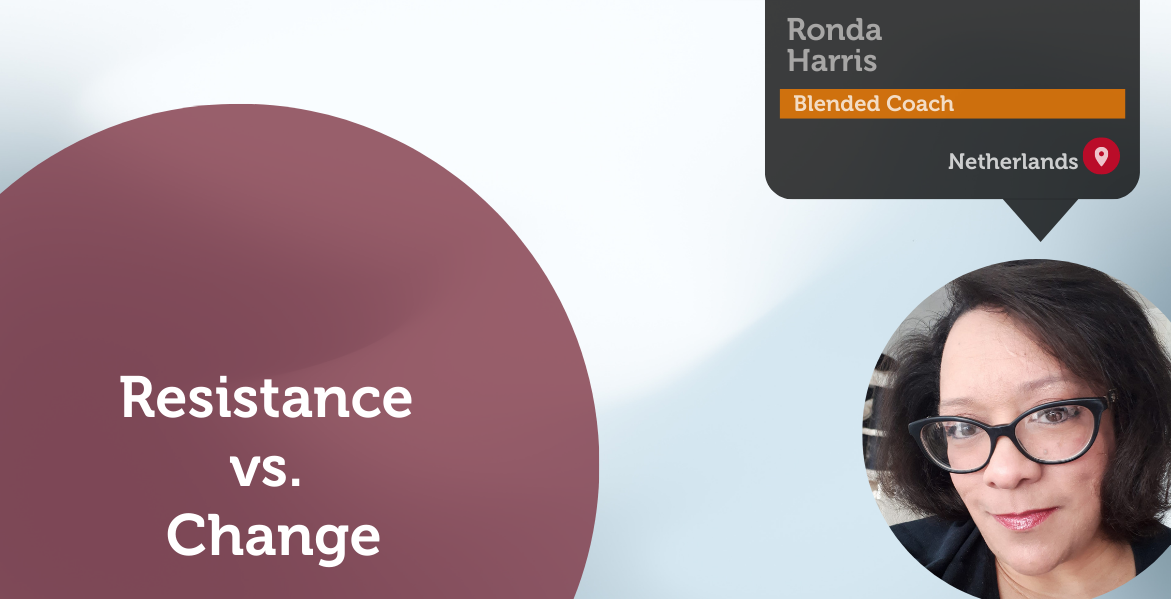A Coaching Power Tool By Ronda Harris, Blended Coach, NETHERLANDS
The ‘Resistance vs. Change’ Coaching Power Tool

Basis of the Coaching Power Tool
The basis for the ‘Resistance vs. Change’ coaching power tool is formed as a result of the principles of change management as an impetus for forward movement. In reflecting on my own coaching sessions, there have been several times when I was able to observe a client switch their mindset. It’s quite remarkable – not only to see them experience the shift for themselves but also it is rewarding as a coach to see the impact that coaching has on people.
Incorporating a change approach within the coaching environment is highly beneficial when addressing resistance. Helping individuals become aware of what holds them back is foundational to eliciting a desire to embrace change, being accountable to explore ways to obtain the knowledge needed to grow, committing to enabling changes, and ultimately, mapping out a plan to move forward and sustain and reinforce the change.
Therefore, the basis for the Resistance vs. Change coaching power tool is to ultimately work with clients to specifically address the resistance they experience in order to make the needed changes that will help them fulfill their goals and take on new challenges.
Reflecting on My Own Coaching Practice
Approaching the session from this power tool’s perspective helps to raise awareness; and I have often seen a level of confidence rise from this, especially when I ask clients to recall prior feelings related to the sorts of strengths they need in order to move forward and accomplish what lies ahead. Once they are able to take a proper inventory of their strengths, characteristics, skills, etc., their belief in themselves starts to build. This makes for a very powerful session and often results in the client leaving with a new way of looking at things and an inspiration to start making changes.
Powerful Perspectives
The Impact of Perspective in a Coaching Setting
I’ve coached several people who desire to start a new business or change careers. Often these experiences are overwhelming for clients as they may find themselves stuck and unable to move forward with the decision, or they suffer from imposter syndrome and doubt their ability or validity to do a certain thing. This can be an obstacle for the client as they are often unable to see themselves the way others see them.
Often the client is filled with doubt and/or a lack of motivation. They may say things like, “I’m not sure I am good enough to charge people for what I do”, “What gives me the right to enter into this area of business?”, or “I really want to change careers but I don’t know if I am good enough in the new field I want to enter.” These thought patterns are usually paired with a description of inactivity or failure to take initiative or take action to get things started and moving in the direction the client says they want to go.
In this case, in order to help raise awareness, I may inquire about the emotions tied to this inaction and lack of motivation. Usually, this leads to the client sharing the feelings they have, many of which are fear-based and have to do with a sense of inadequacy. Upon further exploration, it may be evident that the client seems to be detached from the real-life experiences and/or recognition related to past successes they’ve had, and the fact that their current strengths and skills can be applied to new ventures.
Resistance as a Concept
As necessary as change is in order to move forward, resistance is that nagging shadow counterpart that keeps people stuck in old mindsets and behavior patterns. Resistance can show up in many ways. The client may make excuses for not moving forward, like not having enough time, money, or other resources; or they may rely on the delusion of perfectionism, insisting that they need to wait for certain things to be just right before they take action. They may even convince themselves that sticking with the status quo is fine with them and that they have changed their mind about the goals they want to accomplish. These are all forms of resistance, a debilitating state of mind that holds people back from achieving great things and being self-actualized.
Change as a Concept
Individual change management is extremely powerful and, used in a coaching setting, is an integral part of helping individuals achieve the outcomes they desire. As awareness is the first step towards making a change, the client is forced to address the nature of the change, why it is needed, and what is at stake if they don’t change.
“[During] the first era of change management…, the focus was on improving our collective understanding of human beings, how we experience change, and how our human systems interact and react. In the early 1900s, Arnold Van Gennep was a cultural anthropologist studying rites of passage around the globe… [and] introduced change as happening in three states: separating from our current state, moving through a transition, and reincorporating into a future state (examples include adolescence, marriage, parenthood).” (“The History and Future of Change Management”; March 15, 2023, )
I have chosen this “flipped” perspective as an alternative to resistance because it is instrumental in helping people combat resistance in order to move forward. The benefit of taking this approach is that its inherent function is to focus on the individual in a wholistic way to help them face whatever obstacles lie ahead – whether real or perceived – and to strategically plan a path forward toward adopting new ways of being, by implementing new behaviors, and to ensure the changes endure by planning ahead and preparing reinforcement measures.
Using the ‘Resistance vs. Change’ Coaching Power Tool
An Overview of Resistance and Change in a Coaching Context
Using this Power Tool to Reframe a Perspective – Self Application
There are multiple factors that influence the degree to which a person is actually ready to change, and coaching can be a key part of helping a client to uncover and work through the following:
- Their view of the current state of things
- How they perceive problems
- Pros and cons of the reasons for changing
- The opportunity costs associated with not changing
By implementing coaching best practices, we simultaneously address the very needs and concerns that often arise as resistance. In order to help the client “flip” from one state to another, change management is an ideal approach. While it is the work of the client to reach important milestones along the way, it is the work of the coach to help get them there.
Change is often associated with loss, inconvenience, or even a threat… but it is nonetheless necessary. Therefore, while change is a catalyst for achieving outcomes, resistance is a common obstacle that often manifests as fear, uncertainty, procrastination, cognitive dissonance, or limiting beliefs (creating a false narrative) and sometimes, ultimately an outright refusal to embrace new ideas and concepts or take necessary action.
So how can we address our own resistance? Just as we would in a coaching setting, it is important to first be self-aware of our feelings about the changes we want or need to make. This starts with analyzing the meaningfulness behind what’s driving the change.
Partnering with Clients to Shift a Perspective – The Coaching Application
For example, it could be that a person knows they need to take measures to improve their health, but they are resistant to getting started with a new nutritional plan or exercise routine. However, upon further reflection, he or she would assess the opportunity cost of not making the change (such as poor health outcomes), and then work through the pros and cons of the decision.
Having a level of awareness can help us to look further into the situation and devise a means for eliciting the desire to change. Then, we can move forward and work through gaining knowledge and gathering resources to aim our actions toward our goals, and ultimately to adopt a new way of doing things in order to accomplish what we want and need.
For many, achieving goals or moving forward not only can be facilitated through coaching but often a change is required – a change in mindset, routine, actions, etc. But change is also often uncomfortable and even intimidating. Using the ‘Resistance vs. Change’ coaching power tool, elements of a change model (such as the Prosci ADKAR model) are very helpful when the client exhibits resistance to making changes related to their goals.
Techniques for Managing Resistance: During the coaching session it may become necessary to raise awareness by helping the client reflect on the meaningfulness and rationale for the outcomes they want. You as the coach can help the client work through what it is about achieving the outcomes that they desire the most, helping them address any concerns they have and explore how making changes may ultimately benefit them.
While it is not our role as a coach to dictate what steps a client should take to move forward, we can ask the right questions to help them explore any gaps that may get in the way. For example, they may need to research resources they’ll need to increase knowledge or gain information about topics or training to enable them to complete their goals. This is a decision for them to explore and make. However, working through the change model as a guide can help.
As part of the coaching relationship, you as the coach can help the client achieve personal development, and that may require a plan that’s designed to ensure the client’s ability to work toward goals and achieve outcomes.
Finally, as you and the client work together, and as they achieve successes along the way, it’s ideal to work to help reinforce the changes they make.
